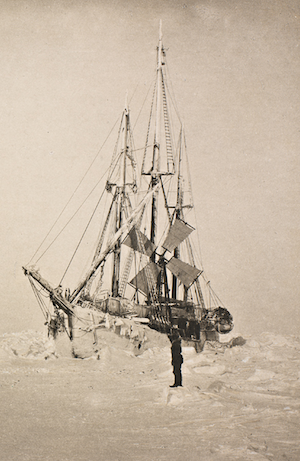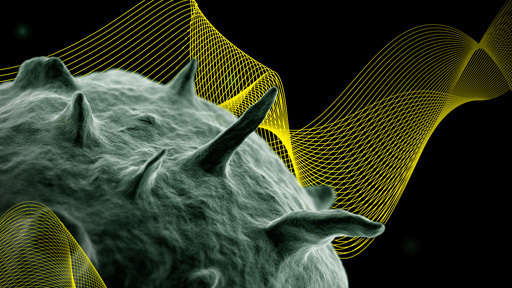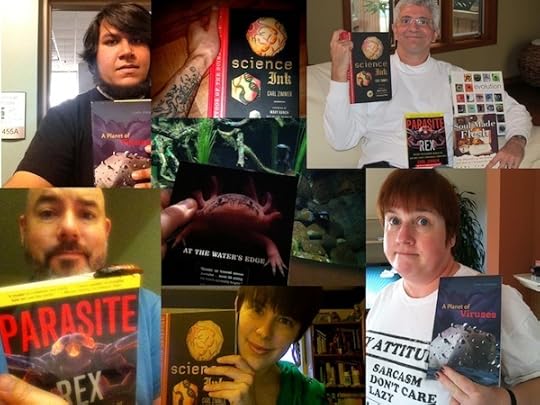Carl Zimmer's Blog, page 43
June 4, 2012
Drawing two million branches: My story in tomorrow’s NYTimes on building the full tree of life
Even the most elaborate pictures of the tree of life you can find online are gaunt shadows of life’s full diversity. In tomorrow’s New York Times, I write about a team of scientists who are setting out to build a tree with every described species on Earth–and program it so that the entire scientific community can help tease out its branches and add more branches as they discover the six, sixty, or six hundred million more unnamed species on Earth. Check it out.
June 3, 2012
Of Victorian Chemists and Online Pornographers: Catching Up With Download the Universe

Here’s a round-up of the latest pieces over at Download the Universe, the science ebook review.
How a Locked-in Woman Took Control of a Robot Arm You may have read in the news last month. Ed Yong admires an ebook that gets behind the headlines and tells the personal story of the paralyzed woman who made cybernetic history.
What the Moon is Really Made of Veronique Greenwood takes a lunar adventure with an ebook written by a team of geologists
Inside the Atavist: A conversation with Evan Ratliff The innovative ebook publisher the Atavist has just attracted investment from the likes of Eric Schmidt at Google. I Skyped the Atavist’s co-founder Evan Ratliff to talk about his experiences and plans for the future.
Science by Candlelight There are lots of fantastic free science ebooks waiting for you to read–historical works that are now in public domain. Deborah Blum looks at a delightful classic–Victorian chemist Michael Faraday’s meditation on the world in a candle flame.
At the Edge of Life Jude Isabella reviews an ebook about the science of near death experiences and ponders how science writers should cover such charged topics.
May 30, 2012
World Science Festival: Resilience and Books This Weekend
 It’s hard to believe that the World Science Festival is now in its fifth year. What started out feeling like an experiment is now a New York institution. I’m looking forward to participating yet again, and hope you’ll be able to join me.
It’s hard to believe that the World Science Festival is now in its fifth year. What started out feeling like an experiment is now a New York institution. I’m looking forward to participating yet again, and hope you’ll be able to join me.
On Friday I’ll be moderating an event called “Illuminating Resilience.” Four experts will discuss how people withstand life’s hardest shocks, and manage to bounce back.
When: Friday, June 1, 10:00 AM – 11:30 AM
Where: NYU Global Center, Grand Hall. 238 Thompson St, New York, NY 10012. Map
More details and ticket ordering information here.
On Saturday afternoon, The World Science Festival will be holding a free event called, “Meet the Authors:
Conversations with Best-Selling Science Writers”
I’ll be kicking things off at 1 pm with a talk about Science Ink. We’ll have temporary tattoos, special guests, and other surprises. And then stick around for other writers, including Lawrence Krauss and E. O. Wilson.
Where: NYU Kimmel Center, Commuter Lounge, 60 Washington Square South, New York, NY 10012 (2nd Floor, Room 203) Map
May 28, 2012
Thanks to readers!
Just wanted to thank readers who recently sent me requests for signed bookplates. To make sure that I was dealing with human readers, instead of Ebay robots, I asked folks to send me a picture. Here are a few.
The offer continues to stand: if you’ve gotten a book of mine and want to get it signed, I’ve printed up bookplates appropriate to each title. Email a picture with your mailing address and any special signing request.

May 23, 2012
In The Beginning Was the Mudskipper?
 In 1893, the Norwegian zoologist Fridtjof Nansen set off to find the North Pole. He would not use pack dogs to cross the Arctic Ice. Instead, he locked his fate into the ice itself. He sailed his ship The Fram directly into the congealing autumn Arctic, until it became locked in the frozen sea. Nansen was convinced that the ice itself would drift up to the pole, taking him and his crew along for the ride.
In 1893, the Norwegian zoologist Fridtjof Nansen set off to find the North Pole. He would not use pack dogs to cross the Arctic Ice. Instead, he locked his fate into the ice itself. He sailed his ship The Fram directly into the congealing autumn Arctic, until it became locked in the frozen sea. Nansen was convinced that the ice itself would drift up to the pole, taking him and his crew along for the ride.
For two and a half years they drifted with the pack. It gradually became clear to Nansen that The Fram had stopped moving north and was now traveling east instead, back towards Europe. He leaped out of the ship and tried to sled up to the pole, only to discover that the ice he was now traveling on was moving south. Only four degrees away from true north, he decided to retreat. He bolted back for Franz Josef Land.
The Fram meanwhile continued to drift east. After several months, it broke free of the ice, and the crew sailed the ship south to the island of Spitzbergen. There on the bare flats they saw a giant ...

May 19, 2012
A Flu Shot For Life

Why do flu shots only protect us for a single season? Why can’t influenza vaccines be like polio vaccines: get them in childhood and be done with them? Wouldn’t that be the best way to prepare ourselves for the next pandemic?
These are among the questions that will be addressed at next month’s World Science Festival. To lay the groundwork, I’ve written a blog post at the festival web site on where we stand on the road to a universal flu vaccine. At this point, we have good reason to believe that such a vaccine could be invented. Which makes it all the more urgent that we do so. Check it out.

May 17, 2012
The Vital Chain: Why Manta Rays Need Forests
 Manta rays spend their lives in the ocean, sweeping up microscopic animals. And yet scientists have found that their well-being depends on forests. Meadows in the northwestern United States are ecologically linked to salmon thousands of miles out at sea. Today, I’ve got a piece in Yale Environment 360 in which I explore the bonds that join land and sea together. Check it out.
Manta rays spend their lives in the ocean, sweeping up microscopic animals. And yet scientists have found that their well-being depends on forests. Meadows in the northwestern United States are ecologically linked to salmon thousands of miles out at sea. Today, I’ve got a piece in Yale Environment 360 in which I explore the bonds that join land and sea together. Check it out.

May 15, 2012
Tapeworms in the brain: Fearfully common
 We’ve all heard about tapeworms getting into the intestines. That’s bad enough. But sometimes they can also end up in the brain. In my column in the latest issue of Discover, I write about neurocysticercosis, which is shockingly common in some parts of the world, causing an estimated five million cases of epilepsy. Yet neurocysticercosis experts consider the disease as a fairly easy one to wipe out. We have the tools to do it, but not the will. Check it out.
We’ve all heard about tapeworms getting into the intestines. That’s bad enough. But sometimes they can also end up in the brain. In my column in the latest issue of Discover, I write about neurocysticercosis, which is shockingly common in some parts of the world, causing an estimated five million cases of epilepsy. Yet neurocysticercosis experts consider the disease as a fairly easy one to wipe out. We have the tools to do it, but not the will. Check it out.

May 14, 2012
Lost voyages to the North Pole and more: Catching up with Download the Universe
 Over at Download the Universe, we’ve added another crop of entertaining reviews about ebooks that you definitely should–or, in some cases, definitely should not–check out:
Over at Download the Universe, we’ve added another crop of entertaining reviews about ebooks that you definitely should–or, in some cases, definitely should not–check out:
“When an Autism Diagnosis Comes as a Blessing”: Steve Silberman writes a powerful review about the reality of autism and a Kindle memoir about living with the condition.
“Meandering Mississippi: An early journalism iBook is all wet”: Seth Mnookin reads an account of last year’s Mississippi floods and wonders why newspapers are squandering the opportunities that ebooks are offering them.
“A Lost Explorer Returns: Todd Balf’s Farthest North: David Dobbs revels in a well-told story of an ill-fated scientific voyage across the Arctic.
“Leonardo: The First Great Science Ebook”: I take a look at a lavishly-produced ebook about Leonardo da Vinci’s forgotten work as a pioneer of anatomy. Staggeringly impressive.
“A Time Machine for the Face of Earth”: My review of a coffee-table-like ebook about how humans (and other forces) are changing the surface of the planet.
“Artificial Epidemics: You’re Not Sick, You’re Just Overdiagnosed”: Neuroscience blogger “Scicurious” is unimpressed with an ebook that claims that depression and prostate cancer are all in your head. (Confused? You should ...

May 11, 2012
Scanning man’s best friend
 We’ve learned a lot about how the brain works from functional magnetic resonance images. I should clarify: we’ve learned a lot about the human brain. Thousands of people have volunteered to lie down inside fMRI scanners and have the activity in their brains monitored as they perform different kinds of mental tasks, or even just do nothing at all. We must resist the temptation to look at the pretty fMRI images and think they’re just photographs of the mind. They’re actually more like very complex, statistically worked-over graphs. But even with those caveats, there’s a lot to learn from them. But fMRI only works if you hold very, very still. Having been scanned myself for a story a few years back, I can vouch that this experience takes a lot of patience, and a high tolerance for loud buzzing noises and for narrow, confined spaces. Scientists have managed to take fMRI scans of monkeys and rats, but they’ve either been knocked out cold, or restrained so the images of their brains don’t blur. If you can persuade a gorilla to lie peacefully in the bore of a scanner for half ...
We’ve learned a lot about how the brain works from functional magnetic resonance images. I should clarify: we’ve learned a lot about the human brain. Thousands of people have volunteered to lie down inside fMRI scanners and have the activity in their brains monitored as they perform different kinds of mental tasks, or even just do nothing at all. We must resist the temptation to look at the pretty fMRI images and think they’re just photographs of the mind. They’re actually more like very complex, statistically worked-over graphs. But even with those caveats, there’s a lot to learn from them. But fMRI only works if you hold very, very still. Having been scanned myself for a story a few years back, I can vouch that this experience takes a lot of patience, and a high tolerance for loud buzzing noises and for narrow, confined spaces. Scientists have managed to take fMRI scans of monkeys and rats, but they’ve either been knocked out cold, or restrained so the images of their brains don’t blur. If you can persuade a gorilla to lie peacefully in the bore of a scanner for half ...



















